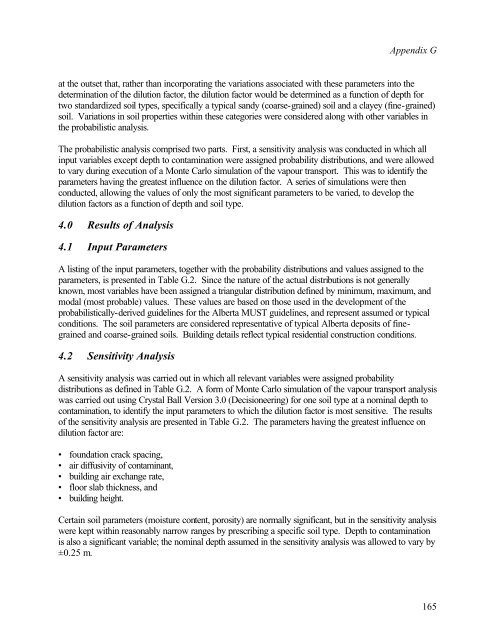Protocol for the Derivation of Environmental and Human ... - CCME
Protocol for the Derivation of Environmental and Human ... - CCME
Protocol for the Derivation of Environmental and Human ... - CCME
Create successful ePaper yourself
Turn your PDF publications into a flip-book with our unique Google optimized e-Paper software.
Appendix G<br />
at <strong>the</strong> outset that, ra<strong>the</strong>r than incorporating <strong>the</strong> variations associated with <strong>the</strong>se parameters into <strong>the</strong><br />
determination <strong>of</strong> <strong>the</strong> dilution factor, <strong>the</strong> dilution factor would be determined as a function <strong>of</strong> depth <strong>for</strong><br />
two st<strong>and</strong>ardized soil types, specifically a typical s<strong>and</strong>y (coarse-grained) soil <strong>and</strong> a clayey (fine-grained)<br />
soil. Variations in soil properties within <strong>the</strong>se categories were considered along with o<strong>the</strong>r variables in<br />
<strong>the</strong> probabilistic analysis.<br />
The probabilistic analysis comprised two parts. First, a sensitivity analysis was conducted in which all<br />
input variables except depth to contamination were assigned probability distributions, <strong>and</strong> were allowed<br />
to vary during execution <strong>of</strong> a Monte Carlo simulation <strong>of</strong> <strong>the</strong> vapour transport. This was to identify <strong>the</strong><br />
parameters having <strong>the</strong> greatest influence on <strong>the</strong> dilution factor. A series <strong>of</strong> simulations were <strong>the</strong>n<br />
conducted, allowing <strong>the</strong> values <strong>of</strong> only <strong>the</strong> most significant parameters to be varied, to develop <strong>the</strong><br />
dilution factors as a function <strong>of</strong> depth <strong>and</strong> soil type.<br />
4.0 Results <strong>of</strong> Analysis<br />
4.1 Input Parameters<br />
A listing <strong>of</strong> <strong>the</strong> input parameters, toge<strong>the</strong>r with <strong>the</strong> probability distributions <strong>and</strong> values assigned to <strong>the</strong><br />
parameters, is presented in Table G.2. Since <strong>the</strong> nature <strong>of</strong> <strong>the</strong> actual distributions is not generally<br />
known, most variables have been assigned a triangular distribution defined by minimum, maximum, <strong>and</strong><br />
modal (most probable) values. These values are based on those used in <strong>the</strong> development <strong>of</strong> <strong>the</strong><br />
probabilistically-derived guidelines <strong>for</strong> <strong>the</strong> Alberta MUST guidelines, <strong>and</strong> represent assumed or typical<br />
conditions. The soil parameters are considered representative <strong>of</strong> typical Alberta deposits <strong>of</strong> finegrained<br />
<strong>and</strong> coarse-grained soils. Building details reflect typical residential construction conditions.<br />
4.2 Sensitivity Analysis<br />
A sensitivity analysis was carried out in which all relevant variables were assigned probability<br />
distributions as defined in Table G.2. A <strong>for</strong>m <strong>of</strong> Monte Carlo simulation <strong>of</strong> <strong>the</strong> vapour transport analysis<br />
was carried out using Crystal Ball Version 3.0 (Decisioneering) <strong>for</strong> one soil type at a nominal depth to<br />
contamination, to identify <strong>the</strong> input parameters to which <strong>the</strong> dilution factor is most sensitive. The results<br />
<strong>of</strong> <strong>the</strong> sensitivity analysis are presented in Table G.2. The parameters having <strong>the</strong> greatest influence on<br />
dilution factor are:<br />
• foundation crack spacing,<br />
• air diffusivity <strong>of</strong> contaminant,<br />
• building air exchange rate,<br />
• floor slab thickness, <strong>and</strong><br />
• building height.<br />
Certain soil parameters (moisture content, porosity) are normally significant, but in <strong>the</strong> sensitivity analysis<br />
were kept within reasonably narrow ranges by prescribing a specific soil type. Depth to contamination<br />
is also a significant variable; <strong>the</strong> nominal depth assumed in <strong>the</strong> sensitivity analysis was allowed to vary by<br />
±0.25 m.<br />
165
















